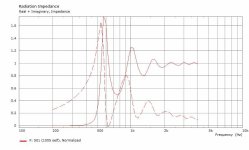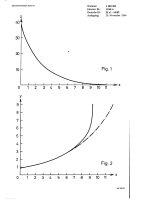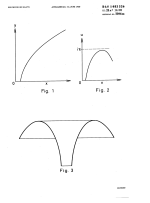i disagree too Tratrix is the way to do if you want to go very low and not have a 1meter diameter horn as with the JMLC profile , Goto Horns goes very low and don't have a trumpet effect if you cross them well . i always prefer round horn tratrix or exponential like JABO or anvantgarde horns. I have a pair of ARAI 480 at home and prefer it as deco than to use them in a speaker..

Last edited:
I disagree.
Tractrix loading is poor.
Tractrix directivity control is also poor.
Tractrix theory is wrong (constant radius wavefronts is a physical impossibility).
"Trumpet effect" is completely unrelated to horn length.
Newell and Holland inferred this wrongly, and their own inference is contradicted by their own admission in their published research that a longer Fostex wooden radial horn had the least "horn/trumpet sound" of all tested devices.
Just to be clear: I'm not a proponent of Tractix per se
Tractrix loading is sufficient for mid/high duties.
Directivity isn't up with the best, but can be decent when the horn is short
Regarding trumpet effect: I've noticed it, especially with longer axisymmetrical horns. Of course it depends on the implementation (passband a.o.), listening distance etc. Have you listened to older Avantgarde Trios and the latest version?
Radial horns, as you use yourself, are of course devoid of this effect (the horn physically differs from a trumpet resulting in a different perception), but radial horns usually exhibit pattern flip and unfortunately I am also sensitive to that phenomenon > shift in image when walking across the room.
Overall, I agree with Newell and Holland's findings, which remains the most thoroughly conducted study of its kind.
This is not correct. The loading of a native Tractrix profile is acceptable good but as the profile does not expand fast enough in the mouth region and because of the fact that the mouth area is quite small one get huge resonances for the radiation impedance around the cut-off (here 425 Tractrix horn):I disagree.
Tractrix loading is poor.
[...]

This is why I introduced my true expansion tractrix horn.
Here 😉Docali, where does one go to read about your horns?
Personally I'm in favor of shortening existing horn profiles as Manfred Harsdorff did at Siemens Klangfilm and Docali has implemented in his spreadsheets.

Last edited:
Just to mention, I don't like Tractrix horns ;-) The true expansion Tractrix horn was simply a theoretical study object. Maybe if someone is interested I could provide the one dimensional coordinates for a round horn. But directivity control will be indeed poor.
Just a random shape, took me 5 minutes including the BEM analysis 🙂
https://www.desmos.com/calculator/sug3snaxgg



https://www.desmos.com/calculator/sug3snaxgg
Love this thread, very informative. I really want to try a pair of the RCF 850 1.4" but in what horn!
Just a random shape, took me 5 minutes including the BEM analysis 🙂
https://www.desmos.com/calculator/sug3snaxgg
View attachment 1186507 View attachment 1186508
View attachment 1186509
Should work from about 500 Hz in a hifi setting.
Roundover aside, the profile probably isn't much different from Newell and Holland's AX2 horn.
As well as this one:
Last edited:
Sure, as almost any horn (or waveguide) with a 1.4" throat.Should work from about 500 Hz in a hifi setting.
But it can't be "roundover aside". That's an integral part of making a good horn, free of any "trumpet effects". No matter how long it is.Roundover aside, the profile probably isn't much different from Newell and Holland's AX2 horn.
BTW, I agree with marco_gea, and I said it many times, that the N&H analysis is mostly buIIshit.
- A 2" version:
https://www.desmos.com/calculator/s2x3tuc1gp
Last edited:
Ideally, the roundover/mouth termination is an integral part of a horn.
This doesn't alter the fact that an existing profile can be revised, including a mouth termination, as Mansdorff did.

You can also use every driver full range without a horn, but whether that's ideal...
My opinion - in line with many of Newell & Holland's findings - remains strictly personal. Fortunately, audio is not a religion or fascist ideology.
This doesn't alter the fact that an existing profile can be revised, including a mouth termination, as Mansdorff did.

You can also use every driver full range without a horn, but whether that's ideal...
My opinion - in line with many of Newell & Holland's findings - remains strictly personal. Fortunately, audio is not a religion or fascist ideology.
Last edited:
Sure, one can do many things. But the acoustic result is what counts and that doesn't look as a very nice device to me.
BTW, this is 2" throat, axisymmetric horn ⌀880 x 500 mm:
https://www.desmos.com/calculator/gcqpk1l1ww


Still no trumpets here 🙂
BTW, this is 2" throat, axisymmetric horn ⌀880 x 500 mm:
https://www.desmos.com/calculator/gcqpk1l1ww
Still no trumpets here 🙂
As the drivers are all band-pass devices by construction, it would not be very clever to try that...You can also use every driver full range without a horn, but whether that's ideal...
That should be definitely better than any conical exit, but perhaps even better is to start the horn contour right at the phase plug exit within a driver that has a conical exit (preferably a wide-angle one) - simply because the effective throat radius will be smaller. The smaller, the better. Requires a custom solution, of course.Have anyone tried the Lavoce drivers? Their phaseplug design doesn't really have an exit angle due to the shallow design which is interesting
Last edited:
Sure, one can do many things. But the acoustic result is what counts and that doesn't look as a very nice device to me.
BTW, this is 2" throat, axisymmetric horn ⌀880 x 500 mm:
https://www.desmos.com/calculator/gcqpk1l1ww
View attachment 1186534 View attachment 1186535
Still no trumpets here 🙂
Perhaps a 1" version with R=180?
- Home
- Loudspeakers
- Multi-Way
- Best Compression Drivers today 2022?
